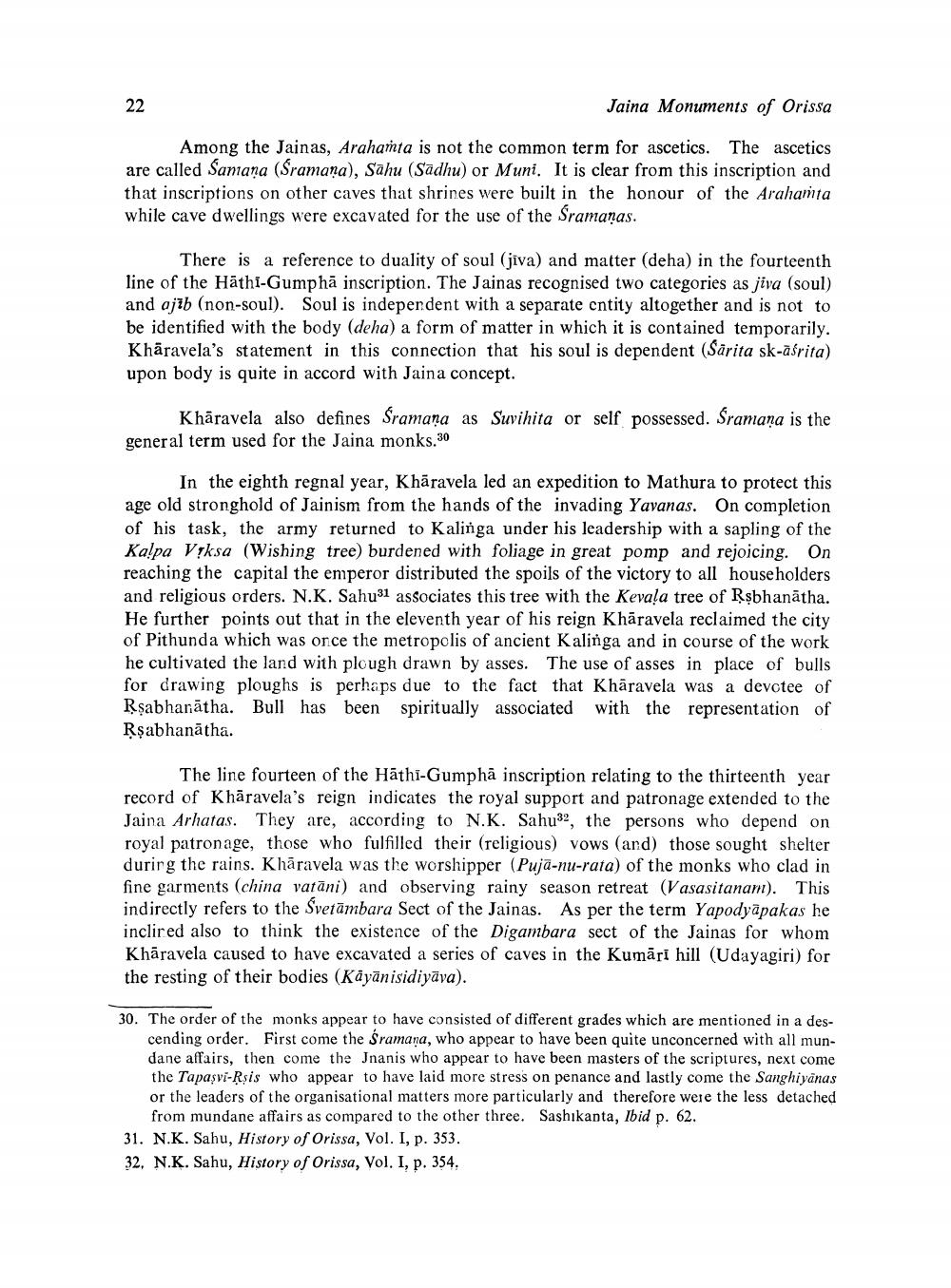________________
Jaina Monuments of Orissa
Among the Jainas, Arahamta is not the common term for ascetics. The ascetics are called Samana (Sramana), Sahu (Sadhu) or Muni. It is clear from this inscription and that inscriptions on other caves that shrines were built in the honour of the Arahamta while cave dwellings were excavated for the use of the Sramaņas.
There is a reference to duality of soul (jiva) and matter (deha) in the fourteenth line of the Hāthi-Gumphā inscription. The Jainas recognised two categories as jiva (soul) and ajib (non-soul). Soul is independent with a separate cntity altogether and is not to be identified with the body (deha) a form of matter in which it is contained temporarily. Khāravela's statement in this connection that his soul is dependent (Sarita sk-asrita) upon body is quite in accord with Jaina concept.
Khāravela also defines Sramana as Suvihita or self possessed. Sramana is the general term used for the Jaina monks.30
In the eighth regnal year, Khāravela led an expedition to Mathura to protect this age old stronghold of Jainism from the hands of the invading Yavanas. On completion of his task, the army returned to Kalinga under his leadership with a sapling of the Kalpa Vīksa (Wishing tree) burdened with foliage in great pomp and rejoicing. On reaching the capital the emperor distributed the spoils of the victory to all house holders and religious orders. N.K. Sahu31 associates this tree with the Kevala tree of Rşbhanātha. He further points out that in the eleventh year of his reign Khāravela reclaimed the city of Pithunda which was once the metropolis of ancient Kalinga and in course of the work he cultivated the land with plough drawn by asses. The use of asses in place of bulls for drawing ploughs is perhaps due to the fact that Khāravela was a devotee of Rşabharatha. Bull has been spiritually associated with the representation of Rşabhanātha.
The line fourteen of the Hathi-Gumphā inscription relating to the thirteenth year record of Khāravela's reign indicates the royal support and patronage extended to the Jaina Arhatas. They are, according to N.K. Sahu32, the persons who depend on royal patronage, those who fulfilled their religious) vows (and) those sought shelter during the rains. Khāravela was the worshipper (Puja-nu-rata) of the monks who clad in fine garments (china vatāni) and observing rainy season retreat (Vasasitanani). This indirectly refers to the Svetāmbara Sect of the Jainas. As per the term Yapodyāpakas he inclired also to think the existence of the Digambara sect of the Jainas for whom Khāravela caused to have excavated a series of caves in the Kumāri hill (Udayagiri) for the resting of their bodies (Kāyānisidiyāva).
30. The order of the monks appear to have consisted of different grades which are mentioned in a des
cending order. First come the Śramana, who appear to have been quite unconcerned with all mundane affairs, then come the Jnanis who appear to have been masters of the scriptures, next come the Tapaşvi-Rsis who appear to have laid more stress on penance and lastly come the Sanghiyanas or the leaders of the organisational matters more particularly and therefore were the less detached
from mundane affairs as compared to the other three. Sashikanta, Ibid p. 62. 31. N.K. Sahu, History of Orissa, Vol. I, p. 353. 32. N.K. Sahu, History of Orissa, Vol. I, p. 354.




